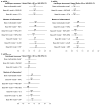Estimated GFR and risk of hip fracture in older men: comparison of associations using cystatin C and creatinine
- PMID: 23890927
- PMCID: PMC3833961
- DOI: 10.1053/j.ajkd.2013.05.022
Estimated GFR and risk of hip fracture in older men: comparison of associations using cystatin C and creatinine
Abstract
Background: Higher serum cystatin C level is associated with an increased risk of hip fracture in postmenopausal white women, but there is a paucity of data for men. Whether estimated glomerular filtration rate (eGFR) based on cystatin C (eGFRcys) is superior in predicting hip fracture risk to eGFR based on creatinine (eGFRcr) or the combination (eGFR(cr-cys)) also is uncertain.
Study design: Nested case-cohort.
Setting & participants: Participants enrolled in the Osteoporotic Fractures in Men (MrOS) Study (5,994 men aged ≥ 65 years from 6 US centers) including a random subcohort of 1,602 men and 168 men with incident hip fractures (51 of whom were in the subcohort).
Predictor: eGFR(cys), eGFR(cr), and eGFR(cr-cys) computed using the CKD-EPI (Chronic Kidney Disease Epidemiology Collaboration) equations and expressed in categories of <60, 60-74, and ≥ 75 mL/min/1.73 m(2) (referent group).
Outcome: Incident hip fracture ascertained by participant contacts every 4 months and confirmed with radiographic reports.
Results: Median eGFR(cys) was 72.9 (IQR, 60.5-85.7) mL/min/1.73 m(2). In unadjusted models, all measures of eGFR were associated with increased hip fracture risk. However, after adjustment for age, race, site, and body mass index, the association of lower eGFR(cys) (but not lower eGFR(cr) or lower eGFR(cr-cys)) with higher hip fracture risk remained: for <60 versus ≥ 75 mL/min/1.73 m(2), HRs were 1.96 [95% CI, 1.25-3.09], 0.84 [95% CI, 0.52-1.37], and 1.08 [95% CI, 0.66-1.77] for eGFR(cys), eGFR(cr), and eGFR(cr-cys), respectively. Similarly, after adjustment for age, race, site, and body mass index, eGFR < 60 mL/min/1.73 m(2) defined by eGFR(cys), but not eGFR(cr) or eGFR(cr-cys), was associated with higher hip fracture risk. The association between eGFR(cys) and hip fracture was not explained by levels of calciotropic hormones or inflammatory markers, but the relationship was attenuated and no longer reached significance (for <60 vs ≥ 75 mL/min/1.73 m(2): HR, 1.43; 95% CI, 0.88-2.34) after consideration of additional clinical risk factors and bone mineral density.
Limitations: Findings not generalizable to other populations; residual confounding may exist.
Conclusions: Older community-dwelling men with lower eGFR(cys) have an increased risk of hip fracture that is explained in large part by greater burden of risk factors among men with lower eGFR(cys). In contrast, lower eGFR(cr) or lower eGFR(cr-cys) was not associated with a higher age-adjusted hip fracture risk.
Keywords: Kidney function; creatinine; cystatin C; elderly; hip fracture; men.
Published by Elsevier Inc.
Figures

References
-
- Seronie-Vivien S, Delanaye P, Pieroni L, Mariat C, Froissart M, Cristol JP. Cystatin C: current position and future prospects. Clin Chem Lab Med. 2008;46:1664–1686. - PubMed
-
- Fried LF, Biggs ML, Shlipak MG, et al. Association of kidney function with incident hip fracture in older adults. J Am Soc Nephrol. 2007;18:282–286. - PubMed
-
- Dukas L, Schacht E, Stahelin HB. In elderly men and women treated for osteoporosis a low creatinine clearance of <65 ml/min is a risk factor for falls and fractures. Osteoporos Int. 2005;16:1683–1690. - PubMed
Publication types
MeSH terms
Substances
Grants and funding
- U01 AR45632/AR/NIAMS NIH HHS/United States
- R01 AG008415/AG/NIA NIH HHS/United States
- U01 AR45647/AR/NIAMS NIH HHS/United States
- U01 AR45614/AR/NIAMS NIH HHS/United States
- U01 AR045654/AR/NIAMS NIH HHS/United States
- U01-AG027810/AG/NIA NIH HHS/United States
- U01 AR045583/AR/NIAMS NIH HHS/United States
- U01 AG042140/AG/NIA NIH HHS/United States
- U01 AR45583/AR/NIAMS NIH HHS/United States
- U01 AR045614/AR/NIAMS NIH HHS/United States
- U01 AR45654/AR/NIAMS NIH HHS/United States
- U01 AR045647/AR/NIAMS NIH HHS/United States
- U01 AR45580/AR/NIAMS NIH HHS/United States
- U01 AG027810/AG/NIA NIH HHS/United States
- AG08415/AG/NIA NIH HHS/United States
- UL1 RR024140/RR/NCRR NIH HHS/United States
- U01 AG18197/AG/NIA NIH HHS/United States
- U01 AG018197/AG/NIA NIH HHS/United States
- U01 AR045580/AR/NIAMS NIH HHS/United States
- U01 AG042139/AG/NIA NIH HHS/United States
- U01 AR066160/AR/NIAMS NIH HHS/United States
- U01 AR045632/AR/NIAMS NIH HHS/United States
LinkOut - more resources
Full Text Sources
Other Literature Sources
Medical
Research Materials
Miscellaneous

